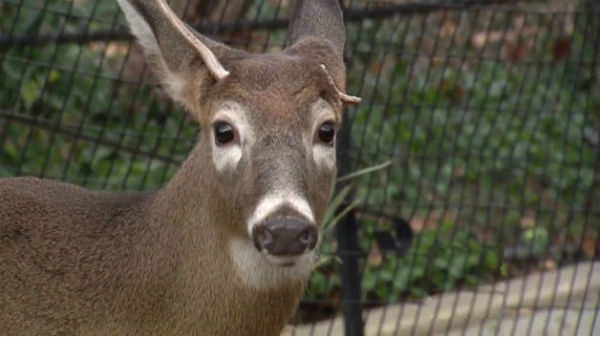 In December 2016, you may remember Bambi, Rudolph And Maybe Dancer Scene In Harlem (pictured above), as they found themselves trapped by spectators and the media in Jackie Robeson Park.
In December 2016, you may remember Bambi, Rudolph And Maybe Dancer Scene In Harlem (pictured above), as they found themselves trapped by spectators and the media in Jackie Robeson Park.
Well, Mayor Bill de Blasio today announced the expansion of WildlifeNYC, an education campaign launched last October to teach New Yorkers how to live responsibly alongside the wild animals that inhabit the city. Previously, the campaign focused largely on deer awareness on Staten Island and in the Bronx. The revamped campaign – now citywide – aims to educate residents in all five boroughs about red-tailed hawks, piping plovers, raccoons, coyotes and deer.
“New Yorkers should know their neighbors,” said Mayor Bill de Blasio. “Our urban environment is home to both humans and animals, so we want human New Yorkers to get educated about their animal neighbors, and to appreciate our city’s ecological diversity by treating them with respect and keeping a safe distance.”
“Our city is home to millions of people, and also millions of wild animals,” said NYC Parks Commissioner Mitchell J. Silver, FAICP. “We want New Yorkers to live in harmony with the more than 600 species who share our city. In an urban setting, animals like raccoons can be viewed as a nuisance, but basic precautions like making sure you aren’t inadvertently feeding raccoons, makes for peaceful co-living.”
The expanded campaign is a collaboration between the Mayor’s Office, NYC Parks, Animal Care Centers of NYC, the New York City Police Department, the Department of Transportation, and the Department of Health and Mental Hygiene. New elements of the campaign include:
- A media campaign visible on buses, subways, taxis and street pole banners throughout the boroughs, encouraging the public to learn about their wild neighbors. To account for each borough’s unique wildlife makeup, certain animals will be featured more prominently in specific boroughs. Piping Plover awareness will be focused in Queens, Coyote awareness in the Bronx and Queens, raccoon and red-tailed hawks in Manhattan and Brooklyn and deer awareness in Staten Island.
- Enhanced resources for New Yorkers on the WildlifeNYC website, which now includes guides for safely coexisting with raccoons, coyotes, piping plovers, red-tailed hawks and deer, as well as fun facts, behavior insight and background on how the City is helping to manage and care for these populations.
As part of the campaign, New Yorkers are encouraged to report wildlife sightings through a web portal on the WildlifeNYC website to help track the movements of each species.
“We welcome these new steps to raise driver awareness and prevent collisions with wildlife on city roadways,” said DOT Commissioner Polly Trottenberg. “To address deer-related crashes on Staten Island and in the Bronx, DOT got the word out with permanent signs and variable message boards to alert drivers. As we further expand public awareness of wildlife beyond only deer, the most important thing drivers can do to avoid a collision with wildlife is to slow down. Drive the posted speed limit, and even slower in areas with known wild animal populations.”
“Many New Yorkers know they don’t need to leave the city to interact with the diverse wildlife that exists within the five boroughs,” said Health Department Assistant Commissioner Mario Merlino, Bureau of Veterinary & Pest Control Services. “The expansion of the WildlifeNYC campaign will reach every corner of the city and teach New Yorkers to respect and appreciate their furry neighbors. If New Yorkers are concerned about animals in their neighborhood, they should call 311 or visit nyc.gov/wildlife.”
“Increased awareness about wildlife in NYC benefits animals of all kinds,” said Animal Care Centers of NYC Field Manager Robert Valles. “We’re happy to be a part of this important initiative and thank Mayor de Blasio, the Parks Department, and all the agencies involved for their commitment to helping New Yorkers coexist with the various species that inhabit our city.”
One of WildlifeNYC’s core initiatives is the City’s deer management program in Staten Island. NYC Parks estimates there are about 2,000 deer on Staten Island, causing vehicle collisions and damaging trees and native plants. The City has developed a multi-pronged plan to address these negative impacts, including traffic safety measures and the humane sterilization of male deer. To date, 720 males have been sterilized (92 percent of antlered males).
To learn more about WildlifeNYC, visit nyc.gov/wildlife.
“In a big city, it is easy to forget that we live in an ecosystem with wild animals,” said Brooklyn Borough President Eric L. Adams. “We must take care to be mindful of the raccoons, red-tailed hawks, and other animals that fly or roam around the streets of Brooklyn every day. That means raising awareness around cohabitating with our furry neighbors in a peaceful and safe manner without disturbing their living areas or having them disrupt our day-to-day lives.”
Though New York is most often thought of as an urban metropolis, the City is also home to a substantial wildlife population…
“Though New York is most often thought of as an urban metropolis, the City is also home to a substantial wildlife population,” said Council Member Mark Levine, Chair of the Committee on Parks. “Through outreach and education, WildlifeNYC ensures that New Yorkers have the information they need to understand the importance and impact of wildlife on our neighborhoods. I applaud the Parks Department for their successful rollout of this program, and I am confident that its expansion will allow the program to continue thriving in years to come.”
Become a Harlem Insider!
By submitting this form, you are consenting to receive marketing emails from: Harlem World Magazine, 2521 1/2 west 42nd street, Los Angeles, CA, 90008, https://www.harlemworldmagazine.com. You can revoke your consent to receive emails at any time by using the SafeUnsubscribe® link, found at the bottom of every email. Emails are serviced by Constant Contact








